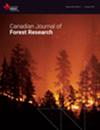Hydrological and nutrient regulation per occupation unit differ between structurally contrasting native and planted forests in the Northern Andes
IF 1.5
3区 农林科学
Q2 FORESTRY
引用次数: 0
Abstract
Understanding ecohydrological dynamics that result from land-use conversions is fundamental in managing ecosystem services. One common forest transformation in the tropics is the establishment of monospecific plantations with exotic species for timber exploitation, replacing highly diverse natural forests. The impacts of establishing forest plantations in hydrological processes and biogeochemical dynamics, have been highly controversial, with functions from structurally homogeneous plantations being sometimes assumed to be comparable to natural forests. To assess the effects of planting exotic conifer species versus natural forests on hydrological and biogeochemical functions, we measured incoming precipitation, throughfall and stemflow. To compare between forest types, we propose the use of basal area for standardization of hydrochemical fluxes. While net precipitation was similar among forest types, the transmission of water to the forest floor per basal area unit was significantly higher in native forests. Yet, nutrient concentrations were similar among them. However, greater nutrient enrichment per unit basal area was observed for the native species. This more efficient nutrient cycling could be related to native forests being better adapted to oligotrophic soils. The re-establishment of native species rather than with exotic species can result in more efficient hydrochemical regulation, improving the capacity of these ecosystems to produce services.在北安第斯山脉结构对比鲜明的原生森林和人工林之间,每个职业单位的水文和营养调节不同
了解土地利用转换产生的生态水文动态是管理生态系统服务的基础。热带地区一种常见的森林改造是建立单一物种的人工林,用外来物种进行木材开采,取代高度多样化的天然林。建立人工林在水文过程和生物地球化学动力学中的影响一直备受争议,结构均匀的人工林的功能有时被认为与天然林相当。为了评估种植外来针叶树物种与天然林对水文和生物地球化学功能的影响,我们测量了入射降水量、穿透量和树干流量。为了比较不同的森林类型,我们建议使用基底面积来标准化水化学通量。虽然不同森林类型的净降水量相似,但在原生森林中,每基底面积单位向森林地面的水分传输量要高得多。然而,它们之间的营养素浓度相似。然而,观察到本地物种的单位基底面积养分富集程度更高。这种更有效的养分循环可能与原生森林更好地适应贫营养土壤有关。重建本地物种而不是外来物种可以导致更有效的水化学调节,提高这些生态系统提供服务的能力。
本文章由计算机程序翻译,如有差异,请以英文原文为准。
求助全文
约1分钟内获得全文
求助全文
来源期刊
CiteScore
4.20
自引率
9.10%
发文量
109
审稿时长
3 months
期刊介绍:
Published since 1971, the Canadian Journal of Forest Research is a monthly journal that features articles, reviews, notes and concept papers on a broad spectrum of forest sciences, including biometrics, conservation, disturbances, ecology, economics, entomology, genetics, hydrology, management, nutrient cycling, pathology, physiology, remote sensing, silviculture, social sciences, soils, stand dynamics, and wood science, all in relation to the understanding or management of ecosystem services. It also publishes special issues dedicated to a topic of current interest.

 求助内容:
求助内容: 应助结果提醒方式:
应助结果提醒方式:


